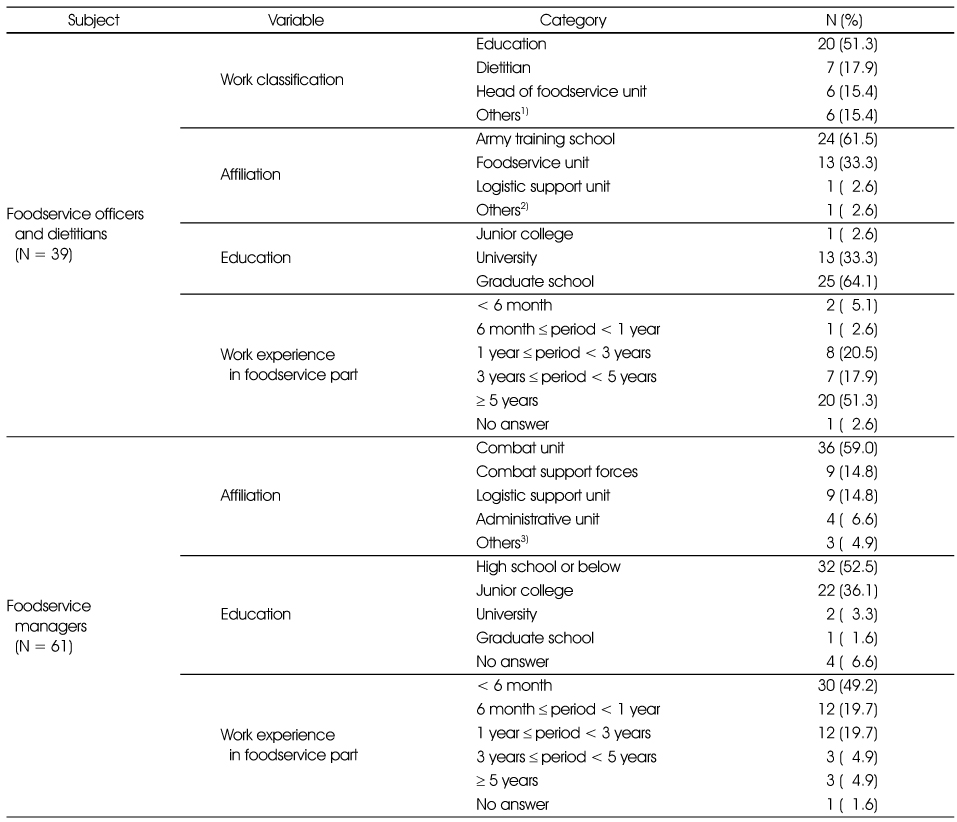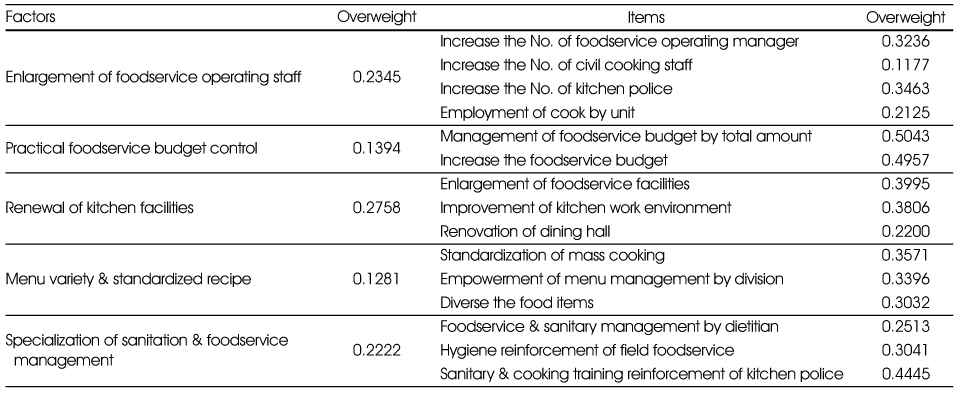Articles
- Page Path
- HOME > Korean J Community Nutr > Volume 19(1); 2014 > Article
-
Original Article
- Application of Analytical Hierarchy Process in Analyzing the Priorities of Strategy for Improving the Army Military Foodservice
- Seung-Hee Baek
-
Korean Journal of Community Nutrition 2014;19(1):51-59.
DOI: https://doi.org/10.5720/kjcn.2014.19.1.51
Published online: February 28, 2014
Department of Foodservice management, Shingu College, Seongnam, Korea.
- Corresponding author: Seung-Hee Baek, 377 Gwangmyeong-ro, Seongnam, Korea. Tel: (031) 740-1571, Fax: (031) 740-1590, moscow@shingu.ac.kr
Copyright © 2014 The Korean Society of Community Nutrition
This is an Open-Access article distributed under the terms of the Creative Commons Attribution Non-Commercial License (http://creativecommons.org/licenses/by-nc/3.0/) which permits unrestricted non-commercial use, distribution, and reproduction in any medium, provided the original work is properly cited.
- 1,068 Views
- 2 Download
- 2 Crossref
Abstract
- The current exploratory study presents the Analytical Hierarchy Process (AHP) as a potential decision-making method to obtain the relative weights of alternatives through pairwise comparison in the context of hierarchical structure. The aim of this study was to elicit prior strategy to improve army military foodservice. Content analysis and seven times of in-depth interview from 13 officers of the Ministry of National Defense were conducted to develop the hierarchical structure for AHP analysis. Questionnaires were distributed to 61 foodservice managers and 39 dietitian and military foodservice officers. The highest-ranked strategy for improving military foodservice was the 'renewal of the kitchen facilities' (0.2578), followed by 'enlargement of foodservice operating staffs' (0.2345), 'specialization of sanitation & foodservice management' (0.2222), 'Practical foodservice budget control' (0.1394), and 'menu variety & standardized recipe' (0.1281). 'Enlargement of foodservice facilities' (0.3995), 'increase the no. of kitchen police' (0.3463), 'sanitary & cooking training reinforcement of kitchen police' (0.4445), 'management of foodservice budget by total amount' (0.5043), and 'standardization of mass cooking' (0.3571) were the highest overweight item in each strategy. The study also compared the relative weights of alternatives of foodservice managers with that of dietitians and military foodservice officers. Those two groups revealed some difference in their priority of important strategy regarding army military foodservice. The results of this study would provide the data for making a policy or compilation of the budget regarding army military foodservice.
-
This research was supported by a grant from the National Research Foundation of Korea (NRF-2008-331-C00316).
NOTES
- 1. Baek SH, Kim SY. Dietary quality estimation of military foodservice menu. Korean J Food Nutr 2010; 23(4): 641-648.
- 2. Baek SH, KIM YS. Investigation of military foodservice operation. Korean J Food Nutr 2010; 23(4): 615-622.
- 3. Cha SM, Yang IS, Baek SH, Kim YJ, Jeong JY. Application of analytical hierarchy process in strategy priority decision-making for brand communication by Korean restaurants overseas. Korean J Food Cult 2012; 27(3): 274-284.Article
- 4. Choi DY, Lee IS. Satisfaction of foodservice and eating behavior of male military personnel in Backryung-do. J East Asian Soc Diet Life 2012; 22(5): 576-584.
- 5. Choi JS, Choe KS, Moon SH. A study of bakery menu addition in military foodservice. Korean J Culinary Res 2004; 10(4): 118-132.
- 6. Jeong SJ. A Survey of Sanitation and Preference for Military Meal Service and Food Behavior and Food Habit of Some Military Personnel. Yosu National University; 2006; 8-9 MS thesis.
- 7. Kang BK, Lee YE. Measuring attitudes and satisfaction level towards military foodservices. J Korean Soc Food Sci Nutr 2011; 40(7): 1032-1042.Article
- 8. Kang KW. The Study of the Improvement Method of the Military Meal Service Support-Lay Emphasis on Manpower Management-. Han-nam University; 2003; 22-25. 28 MS thesis.
- 9. Kim ES, Jung BM. A survey of satisfaction and preference for military meal service and food behaviors and food habits of some military personnel. Korean J Community Nutr 2006; 11(4): 520-533.
- 10. Kim HK, Kim HJ. The development on significancy and priority of KPI in Korea coffee shop business using AHP. Korean J Hosp Adm 2012; 21(5): 195-205.
- 11. Kwon KJ. A study on relative importance and priority for measurement item of franchise level evaluation: Using AHP method. J Foodserv Manage 2013; 16(3): 49-69.
- 12. Lee HS, Han YS, Lee JM. A survey of the customer satisfaction of military foodservice for their improvement. Korean J Community Nutr 2000; 5(3): 522-528.
- 13. Lee JY. Development of the Sanitation Evaluation Tool through Researching of Management Practice at the Military Foodservice. Yonsei University; 2006; 23-31 MS thesis.
- 14. Lee MA, Yang IS, Yi BS, Kim HA, Park SH. Analytic hierachy process approach to estimate weights of evaluation categories for school foodservice program in Korea. Korean J Nutr 2006; 39(1): 74-83.
- 15. Lee MJ, Lee YS. A Survey of satisfaction and preference for military meal services in the Daegu area. Korean J Food Cult 2012; 27(2): 113-127.Article
- 16. Lee YM, Min SH. Preference and perception of seafood among soldiers on cook's duty in military meal service. Korean J Food Cult 2005; 20(6): 668-674.
- 17. Lee YM, Lee WJ, Min SH. A study on seafood dishes in military standard menu. Korean J Food Cult 2003; 18(3): 261-269.
- 18. Ministry of Education. School foodservice policy 2014. Ministry of Education; 2013. p. 3.
- 19. Ministry of National Defense. Military foodservice policy 2008. Ministry of National Defense; 2008. p. 1.
- 20. Ministry of National Defense. Military foodservice policy 2009. Ministry of National Defense; 2009. p. 3.
- 21. Ministry of National Defense. Defense Policy. 2013; cited 2013 October 31]. Available from http://www.mnd.go.kr/cop/kookbang/kookbangIlboView.do?categoryCode=dema0003&boardSeq=1142&id=mnd_020101000000.
- 22. Moon SJ, Sohn KH, Yang IS, Sohn CY, Kim DY. Development in computer program for standardized quantitative recipes in military services. Korean J Food Cult 1991; 7(3): 61-68.
- 23. Rao RV. Evaluation of metal stamping layouts using an analytic hierarchy process method. J Mater Process Tech 2004; 152(1): 71-76.Article
- 24. Saaty TL. Highlight and critical points in the theory and application of the analytic hierarchy process. Eur J Oper Res 1994; 74(3): 426-447.
- 25. Seo DJ. Quality Improvement Proposition through Menu Preference Survey and Reviews of Transition in Korean Military Food Services. Chung-ang University; 2004; 47-49 MS thesis.
- 26. Sohn CY, Yang IS. A analysis of relative importance of evaluation categories for hospital foodservice by analytic hierarchy process. Korean J Food Nutr 2010; 23(4): 470-477.
- 27. Sohn GR, Park MJ, Youn MS, Jeong YH. Soldier satisfaction with military foodservice. J East Asian Soc Diet Life 2006; 16(5): 607-614.
- 28. U.S. Army. BDFA policy. 2014; cited 2014 January 21]. Available from http://www.quartermaster.army.mil/jccoe/Operations_Directorate/QUAD/BDFA/archive/FY2014/BDFA_FY_2014_JAN%20_2014.pdf.
- 29. Vaidya OS, Kumar S. Analytic hierarchy process: An overview of applications. Eur J Oper Res 2006; 169: 1-29.Article
- 30. Yeo WS. Study of menu variety in military foodservice. Korean J Culinary Res 2004; 10(41): 140-152.
REFERENCES
Figure & Data
REFERENCES
Citations

- Safety education status and needs priorities of Korean military food service personnel using the Borich Needs Assessment and the Locus for Focus model: a cross-sectional study
Jeongeun Park, Eunsil Her
Korean Journal of Community Nutrition.2025; 30(4): 261. CrossRef - Analysis of Perception and Satisfaction of Military Foodservice that are Provided According to the Ranks of the Soldiers
Jun-Hee Kim, Se-Jeong Bae
Korean Journal of Community Nutrition.2015; 20(1): 53. CrossRef

Fig. 1
General characteristics of the subjects
1) Instructor, transportation battalion, 2) Ministry of National Defense, 3) Army hospital, boot training battalion
Overall Overweight of factors and items
Overall ranking of factors by groups
Ranking of items by groups
1) Instructor, transportation battalion, 2) Ministry of National Defense, 3) Army hospital, boot training battalion

 KSCN
KSCN





 Cite
Cite


